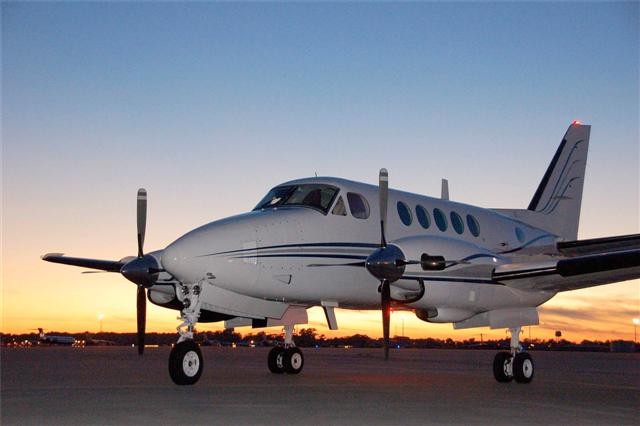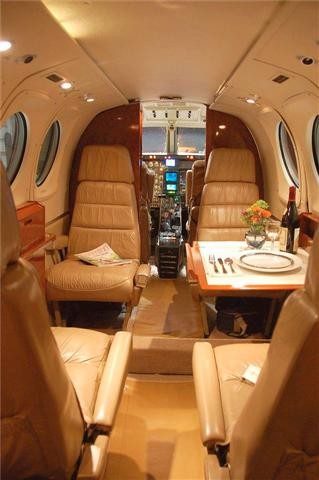


Aircraft Description
Background/History
In January 1964 the first Beechcraft 65-90 took to the air. Based on the piston-engined Model 65 Queen Air, the 65-90 featured then-new Pratt & Whitney Canada PT6A turboprop powerplants in place of the earlier 65’s Lycoming flat six piston engines. A pressurized model was developed, and was designated the King Air 90. Many variants followed including the PT6A-20-powered A90 and B90, and the C90 powered by the -21 variant of the PT6A. In 1969, Beech introduced the Model 100 King Air. It featured a 4.2ft. stretch of the -90’s fuselage to allow high density seating for 15 persons, a new wing with reduced span derived from the wing of the Model 99 Airliner, and enlarged rudder surfaces. In October 1972 Beech began deliveries of the A100 incorporating a series of detail refinements, including four-bladed propellers which significantly decreased cabin noise levels. The success of the 200-series King Airs led to the discontinuance of the A100 in 1979, while the similar B100, powered by the TPE331 engine, was discontinued in 1984.
Power
The King Air A100 is powered by a pair of Pratt & Whitney Canada PT6A-28 turboprop engines each rated at 680shp, driving four-bladed Hartzell full-feathering, reversible, constant-speed propellers. Inspection interval on the engines is 3,600 hours.
Avionics
The King Air A100 was delivered with dual King Gold Crown avionics and RCA AVQ-47 weather radar as standard equipment, but options included dual Collins radios, including the Collins FD-108 flight director and AP-105 autopilot.
Design Features
The King Air A100 is a pressurized, twin-engine turboprop business aircraft configured as a cantilever low-wing monoplane with a conventional tail. The retractable tricycle landing gear utilizes dual wheels on the main gear, and a single tire on the nosewheel unit. A large airstair door is located on the port side of the fuselageaft of the wing. The design utilizes dual engine bleed air for pressurization and cabin heat, with supplemental heat provided by an electric heating system. Full anti-ice and de-ice systems include pneumatic boots on the wing and tail leading edges, electric propeller anti-ice, and electrically heated windshields, pitot, and fuel vents. The four-bladed Hartzell propellers reduce vibration and cabin noise levels in comparison to the three-bladed propellers of the earlier Model 100 King Air.
Accomodations
The King Air A100’s flexible seating system allows for a variety of configurations, but the most common arrangement seats seven, including the belted lavatory seat. A 62 cu.ft. baggage compartment is located in the aft cabin. Noise levels are significantly lower than those of previous King Airs. Cabin height is 4.8 ft., width is 4.5 ft., and cabin length is 16 ft.
| General | King Air A100, BE-100 | |||
|---|---|---|---|---|
| Category | Multiengine Turboprop < 12,500 lbs. | |||
| Years Aircraft Manufactured | 1972 – 1979 | |||
| Serial Number Range | 0090 – 0247 | |||
| Retail High Price | $495,000.00 / 388,426.50€ | |||
| Retail Low Price | $240,000.00 / 188,328.00€ | |||
| Characteristics | King Air A100, BE-100 | |||
| Seating | 1 + 8 | |||
| Wing Loading | 41.2 | |||
| Power Loading | 8.5 | |||
| Noise(EPNdB): Takeoff/Sideline/Approach | 77.3 | |||
| External Dimensions (ft) | King Air A100, BE-100 | |||
| External Length | 39.9 | |||
| External Height | 15.4 | |||
| External Span | 45.9 | |||
| Internal Dimensions (ft) | King Air A100, BE-100 | |||
| Internal Length (Overall/Net Height) | 28.3 | |||
| Internal Height | 4.8 | |||
| Internal Width (Max/Floor) | 4.5 | |||
| Baggage | King Air A100, BE-100 | |||
| External: Cu.Ft./Lb. | N/A | |||
| External: Cu.Ft./Lb. | N/A | |||
| Power | King Air A100, BE-100 | |||
| Engines | 2 P&WC PT6A-28 | |||
| Output (lbs ea.)/Flat Rating | 680 shp | |||
| Inspection Interval | 3,600t | |||
| Data based on latest manufactured year | ||||



